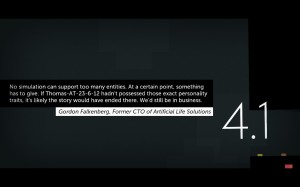Puzzle games and storytelling have been polarizing elements for some time with only a few titles have been able to puzzle the player while telling a story. This made Thomas Was Alone all the more amazing: telling a personal story about faceless rectangles.
Geometry Triumph
The story of Thomas Was Alone was about Thomas: an AI represented by a red rectangle discovering that there is more out there then just doing your job in a computer system. From there, he begins exploring and picks up a motley crew of friends, all represented by rectangles.
The game is a puzzle-platformer with a similar style to the classic game: The Lost Vikings. Here, each rectangle has a different shape, color and abilities that can aid you in each level. The objective is to use all the rectangles available to get them to their respective exit portals.
As you can tell by the screenshots, Thomas Was Alone was a minimalist title: every character was a rectangle with no animation. But the game managed to be greater than the sum of its parts thanks to the music and storytelling.
At the start of every level you’ll hear narration from humorist Danny Wallace on the rectangles and what they are thinking. What’s great is how the story frames the situation for the gameplay, but is 100% removed from actually playing the game.

The overall story moves along at the start of each block of puzzles and helps frame what is happening.
You’ll hear tales of love, jealousy, wonder and even becoming a super hero, and all of that discussed by faceless rectangles.
You could play Thomas Was Alone and enjoy the game for the puzzles and completely ignore the story, but the game was better because of it.
The puzzles themselves were more on the side of action then thought, but were varied enough to keep me interested. The puzzles grew in challenge and complexity as you’ll make use of various combinations of Thomas’s crew.
Thomas Was Alone was a short game, taking me about three hours to conquer all the challenges. But the story did help move me along to see what would happen to Thomas and his friends. Difficulty-wise it was hard to gauge the game which may be one of the few nitpicks I had.
The amount of platformer skill required fluctuated as the game went on. Earlier levels were harder than later levels based on how much was required by the player. There were several cases where I had to switch rectangles in mid action to perform an action quickly.
While not a big problem for someone who is skilled at platformers, for people expecting more puzzles around thought over action, they may be disappointed.
Lastly, since the game was made entirely in 2d, you should have no problem with using either a keyboard or gamepad to make it through.
In an age where developers are pushing graphical fidelity to create more meaningful stories, sometimes less is more and all you need are a few rectangles to tell an amazing story.



